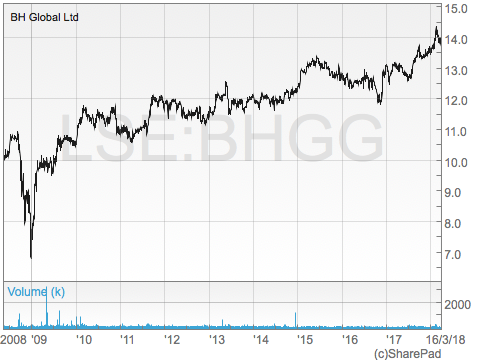How to diversify through alternative assets

One of the most remarkable trends in the financial markets over the last few years has been the rise in popularity of alternative asset classes. This diverse sector includes everything from property and infrastructure, to specialist bond and hedge funds, with the lack of liquidity in these areas making investment trusts the obvious way to gain exposure.
The growth in demand for alternatives has largely been driven by the desire for an attractive and sustainable yield that has the potential to rise in line with inflation. It also reflects a growing concern with the high valuation of more mainstream asset classes, with investors looking for ways to increase their diversification and protect their portfolios.
Research by Canaccord Genuity shows that alternative investment trusts have generated net inflows – new money raised net of cash returned to shareholders – of £22 billion in the last five years, with £5 billion of that coming in 2017. This compares to net outflows of £1.7 billion from equity investment trusts.
Back in 2002, alternatives accounted for just 9% of the market value of the investment trust sector, but that figure has now risen to an astounding 42%. The question for investors is whether these products can continue to deliver against the backdrop of rising interest rates, reduced bond buying by the central banks (Quantitative Easing) and higher market volatility that we are likely to encounter this year.
Infrastructure
Infrastructure funds have attracted a lot of investor interest in recent years due to a high level of income, which tends to rise with inflation. The excess demand had pushed many of these investment trusts on to a substantial premium to their net asset value (NAV), but those with the highest exposure to Private Finance Initiative (PFI) contracts have now been de-rated following the threat by the Labour Party to bring them back in-house, and the collapse of the outsourcer Carillion.
HICL Infrastructure (LON:HICL) has the largest investment in PFI assets in the sector, but the slide from a 9% premium to a small discount has encouraged the analysts at Winterflood, Numis and Canaccord Genuity to stick with their BUY recommendations. HICL has a diversified portfolio of high quality assets and is yielding around 5.4%. It also has the tightest linkage to inflation with each 1% increase resulting in a 0.8% uplift in the fund’s income.
The growth in demand for alternatives has largely been driven by the desire for an attractive and sustainable yield that has the potential to rise in line with inflation.
Another favoured option in this area is International Public Partnerships (LON:INPP), which is recommended by both Numis and Canaccord Genuity. INPP has built up a strong performance record that is underpinned by its ability to source attractive new assets. It is currently yielding 4.6% and trading on a small premium to NAV.
Renewable Energy
Renewable Energy funds achieved net inflows of £822 million in the last five years with the demand buoyed by the improvement in sentiment towards power prices. These projects typically derive about half of their revenues from long-dated government subsidies that rise in line with inflation, with the rest coming from the sale of the electricity generated.
The country’s first renewable energy fund was Greencoat UK Wind (LON:UKW), which raised £260 million in March 2013 and has since had a number of successful placings that have enabled it to increase its market value to £1.2 billion. It is the only UK focused wind fund in the sector and operates 29 different wind farms. UKW has delivered steady returns and is yielding 5.4% with both Numis and Canaccord Genuity including it on their recommended list.
Don’t miss Nick’s next piece in the next edition of Master Investor Magazine – Sign-up HERE for FREE
A more diversified option is the Renewables Infrastructure Group (LON:TRIG), which provides exposure to a mixture of onshore and offshore wind, solar PV and battery storage. It owns a total of 57 renewable energy generation projects and has a market value of around £1 billion. Capital returns have been modest, but it is yielding 6.2% and the analysts at Canaccord Genuity believe that it offers a low cost, low risk exposure to the asset class.
Property
Last year was a particularly active one for the property investment trust sector, with nine separate IPOs and various secondary issues raising around £3.7 billion of new capital. Most of this money was invested in specialist mandates such as social housing, warehouses and healthcare properties, although a number of listings had to be cancelled towards the end of the period because of a lack of demand.
The £1.1 billion F&C Commercial Property Trust (LON:FCPT) owns the highest quality portfolio of properties in the sector with around 55% of the value concentrated in London and the South East. It has a strong long-term performance record and is yielding 4.3% with monthly dividends that it has maintained since launch in March 2005.
A more specialist selection by Winterflood is the £205 million Impact Healthcare REIT (LON:IHR), which was launched in March 2017. The fund owns a portfolio of 57 residential care homes that have been let on 20-year inflation-linked leases. It has a targeted yield of 6% based on the issue price and offers an uncorrelated exposure that should be relatively immune to the economic cycle.
The core buy recommendations from Numis in this area include the £203 million LXI REIT (LON:LXI), which was launched in February 2017 and invests in a portfolio of long-lease assets. These have an average net initial yield of over 6% and an average unexpired lease term to the first break in the contract of 24 years. The fund benefits from a diversified tenant base with almost all of the income being linked to inflation or having fixed periodic uplifts.
They also like the £257 million PRS REIT (LON:PRSR), which launched in May 2017 to invest in newly constructed private rental properties that are to be let on 12-month Assured Shorthold Tenancies to qualifying tenants in the largest English towns and cities outside of London. It is targeting a yield of at least 6% per annum and a total annual return of 10% or more once fully invested and geared.
Specialist bond funds
Many bonds have become extremely expensive with valuations pushed up by the historically low interest rates and the aggressive purchasing by central banks. These areas look vulnerable to rate increases and reductions in the level of Quantitative Easing, with the fixed rate, long-duration notes having the most to lose.
Some of the investment trusts operating in this area should be relatively immune to rising rates, as they hold shorter duration floating rate notes that pay more when interest rates rise. A good example is the £470 million TwentyFour Income (LON:TFIF), which invests in European Asset Backed Securities. It is yielding almost 6% and is recommended by the analysts at Winterflood and Numis.
Some of these areas could be severely tested by changes to the macro environment and those funds that fail to deliver are likely to be hit hard.
Numis also like Funding Circle SME Income (LON:FCIF), which invests in small and medium enterprise loans through the Funding Circle marketplaces. Its typical loan is £67,000 with a gross interest rate of around 10%. This gives the fund an attractive projected net return after bad debts and costs of 7.1% per annum. FCIF is yielding 6.3% and stress tests suggest that the annual return in the event of a 2008 financial crisis-type event would be 5.1%.
BioPharma Credit (LON:BPCR) raised $762 million at its IPO in March 2017 and has invested the proceeds in a portfolio of loans backed by royalties and other cash-flows from sales of approved life-science products. The fund aims to deliver a NAV total return of 8% to 9% per annum over the medium term, with a target dividend yield of 7%. It has recently raised an additional $154 million and is subject to a BUY recommendation by Canaccord Genuity.
Outlook
The growth in popularity of alternative funds has come at a time of low interest rates and low volatility so it remains to be seen how they will perform when challenged on both fronts. Some of these areas could be severely tested by changes to the macro environment and those funds that fail to deliver are likely to be hit hard.
Investors in Empiric Student Property (LON:ESP) know how expensive this can be. The fund invests in high quality student accommodation, but a set of poor results in September and a subsequent reduction in the dividend have resulted in a near 20% fall in the share price over the last year and the departure of its CEO and CFO. Peer-to-peer lender Ranger Direct Lending (LON:RDL) has also suffered due to its poor due diligence and risk controls.
Don’t miss Nick’s next piece in the next edition of Master Investor Magazine – Sign-up HERE for FREE
Market conditions have been a lot more challenging this year and could provide a foretaste of what is to come, but so far most of the alternatives have held up pretty well. The main exceptions have been the infrastructure funds, which have been dragged down by the collapse of Carillion, and some of the specialist property mandates.
Higher interest rates and a reduction in Quantitative Easing by the world’s central banks will inevitably put pressure on the mainstream asset classes. Alternatives will not be immune from these macro challenges, but by carefully selecting individual funds it may be possible to protect and enhance your portfolio returns.
FUND OF THE MONTH
The last few years have been extremely difficult for listed hedge funds as they have struggled to make any sort of headway against the backdrop of low volatility and stable interest rates. One such is BH Global (LON:BHGG), which raised $1 billion when it was launched in May 2008, but has since contracted to $442 million after a series of tender offers and share buybacks. It is possible that the worst could be behind it as the fund would benefit from a less stable macro environment.
At the end of December BHGG had invested 21.8% of its assets in the Brevan Howard Master Fund, which aims to deliver consistent risk-adjusted returns in different market conditions through exposure to a range of trading strategies. A further 8% was allocated to the BH-DG Systematic Trading Master Fund with another 7.2% in the Brevan Howard Asia Master Fund.
The rest of the fund’s assets – over 60% − were allocated to individual traders affiliated to Brevan Howard and it is this Direct Investment Portfolio that has generated the majority of the recent returns. These people employ a variety of different strategies in areas such as credit trading, interest rate trading, foreign exchange, and equity indices.
BHGG’s largest underlying allocation is to Macro Strategies and there is every chance that as central banks take steps to normalise monetary policy it will create an improved trading environment with larger market moves and higher volatility. The strong share price performance during the recent market sell-off could be an indication of what is to come.
The fund’s shares are trading on a 5% discount to NAV and the Board is actively looking to improve the situation through share buybacks. It has also reduced the management fee from 2% to 1% of net assets. If the higher market volatility continues the fund would be well placed to benefit.

Fund Facts
Name: BH Global (LON:BHGG)
Type: Investment Trust
Sector: Hedge Funds
Total Assets: $442 million
Launch Date: May 2008
Current Yield: 0%
Gearing: 0%
Ongoing Charges: 2.37%
Website: www.bhglobal.com
Comments (0)